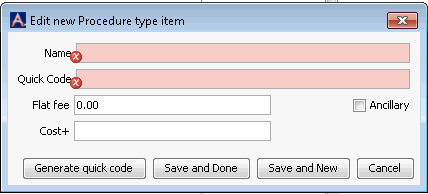Procedure Type dictionary
The Procedure Type dictionary in the Administration module contains a list of the every type of procedure performed at your facility (i.e. orthopedic, bariatrics, etc.).
Entries in the Procedure Type dictionary are associated to Procedures in the Procedure dictionary and are referenced in Scheduling for Templates created for specified Procedure Types. For example, your facility may set aside a block of time on the schedule for Orthopedic procedures. When Procedures associated to that Procedure Type (ex: knee replacement) are scheduled in that Template, that appointment time appears Qualified Time on the Template Utilization Report, which assists your facility in making future decisions about blocking time for Orthopedics.
The Procedure Type is also used as a sorting and/or grouping option in certain financial and clinical reports.
The list of Procedure Types is built by your facility: it does not come pre-built in the system. The Procedure Type dictionary is a Shared dictionary within a Business Group. Items entered in this dictionary will be active and available for use and editing in all Business Entities in the Business Group.
 When adding items to this dictionary
it is important to consider how financial and clinical reports may be
run for the facility. While it is not mandatory, the Procedure Type can
be very helpful for running month end and quality reports.
When adding items to this dictionary
it is important to consider how financial and clinical reports may be
run for the facility. While it is not mandatory, the Procedure Type can
be very helpful for running month end and quality reports.
To add a new Procedure Type
- Click New Item from the
Actions
sectionActions
section in the upper right of the Procedure Type
dictionary. The Edit
new Procedure Type item dialogEdit
new Procedure Type item dialog appears. Complete
at least the Mandatory
fields on this dialog:


- Name: (mandatory) Enter a description of the item. The name must be unique.
- Quick Code: (mandatory) Enter a short name for the item, up to 15 alphanumeric characters long. Quick codes must be unique.
- Flat fee: If your facility bills a flat fee for this Item, enter that fee here. This field is only used for Time & Material line item billing and is not required for ASCs billing with global fees.
- Cost+: If your facility bills Time and Materials for this item instead of a flat fee, enter the amount over cost that is added to line items billed. This field is not required for ASCs billing with global fees.
- Ancillary: This check box is only used for Time & Material billing to identify a procedure done in connection to another procedure. This field is not required for ASCs billing with global fees.
- Generate quick code: If the Preference to Auto generate quick code has been set, this field will be displayed when new items are added to the dictionary. If a quick code has not been set or if you would like to override the code that has been entered in the field, click the button to have the system generate a quick code.
- Click one of the following buttons:
- Save
and DoneSave
and Done
Click to save your changes and return to the Items screen.
- Save
and NewSave
and New
Click to save your changes and clear the fields on the dialog, so you can add another new Item to the Dictionary.
- CancelCancel
Click to discard your changes and return to the Items screen.
- Save
and DoneSave
and Done
Related Topics